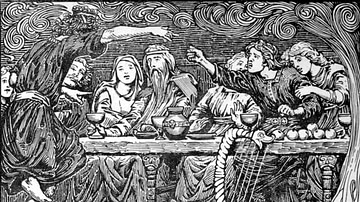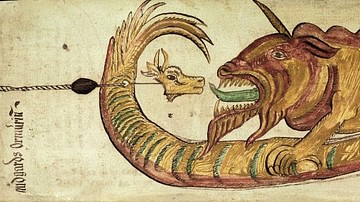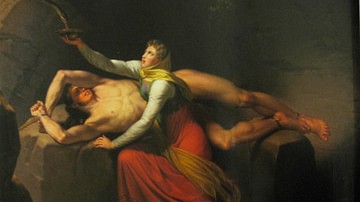A symbol is an image or object which represents an abstract concept, often having to do with one's religious beliefs. Every civilization, from the most ancient to the present, has made use of symbols to make the abstract concrete and visible and to provide assurance that a higher power was interested in, and sympathetic towards, the struggles of human beings.
The symbols used in Norse mythology had to do not only with supernatural entities but also with the challenges of everyday life and the mystery of what awaited after death. Some of these symbols can definitely be dated to the Viking Age (c. 790 - c. 1100 CE) but were no doubt in use much earlier. Other symbols seem to have developed later (between c. 1100 - c. 1300) after Christianity had established itself in Scandinavia.

There were many powerful symbols from the Norse-Viking period ranging from the wolf (for protection), to the horse (protection in travel), the troll cross (an amulet that protected one from trolls), the image of the Vegvisir ('way guide', a late Icelandic symbol which helped one find one's way) and the Web of Wyrd (web of fate), as well as the runes which were thought to evoke mystical powers. Generally, however, ten symbols were the most popular; these appear most often in stories, images, and as amulets:
- Yggdrasil – the World Tree
- The Valknut – Odin's Knot
- The Swastika/Sun-Wheel
- The Aegishjalmur – Helm of Awe
- Mjolnir – Thor's Hammer
- The Sventhorn – Sleep Thorn
- Gungnir – Odin's Spear
- The Ship
- Huginn and Muninn – Odin's Ravens
- The Triskelion – Odin's Horns
These symbols sometimes are found in the form of amulets (such as Thor's hammer), sometimes in depictions of the afterlife (as with the ship) and often in images concerning the journey of life (the swastika/sun-wheel and ship). In whatever context they appear, it is clear they were considered important evocations of powerful supernatural elements.
The Norse religion was non-exclusive and so it is common to find Christian symbols such as the cross paired with a popular pagan symbol such as Thor's hammer. Jesus Christ was initially considered just another god one could count on for protection and direction in life and remained so until Christianity became the dominant faith and the old beliefs died out.
Yggdrasil
The image of the World Tree appears in the mythology of many ancient cultures as a symbol of connection between all things and the cyclical nature of life: nothing ever finally dies, everything is constantly in a state of unending – and natural – transformation. According to scholar H. R. Ellis Davidson, Yggdrasil is "one of the most powerful symbols in Norse mythology, said to stand at the centre of the worlds of gods and men" (Myths and Symbols, 23). The nine realms of existence – all the seen and unseen worlds – were nestled in its roots including Jotunheim, the giants' realm, where Mimir's Well of Wisdom lay.

Although there remains much debate on the issue, it is generally agreed that Yggdrasil was an ash tree and that its name means "Odin's Horse" as in the tree to which the highest god's horse is bound but could also mean "tree of terror" as it is the tree on which Odin hung when he sacrificed himself to himself in his quest for wisdom (Simek, 375). The death-dragon Nidhoggr gnaws at the tree's roots while the eagle of discord nests in its upper branches and a squirrel named Ratatoskr runs up the trunk and back down delivering messages between the two. The dragon, eagle, and squirrel are all symbols of change as not even Yggdrasil will last forever. In the final battle of Ragnarok, the twilight of the gods and end of the world, Yggdrasil will be destroyed along with everything else but will be reborn afterwards in a new world.
Valknut
The Valknut (Odin's Knot) is a symbol of the transition between life and death and, according to Davidson, "is thought to symbolize the power of the god to bind and unbind" (Gods and Myths, 147). Among Odin's many supernatural attributes is his role as psychopomp, a figure who guides the souls of the dead to the afterlife. The name of the symbol is usually translated as "knots of those fallen in battle" signifying warriors gathered by Odin's Valkyries from the battlefield and brought to Valhalla.

The symbol is often associated with that of Hrungnir's Heart (the heart of a giant defeated by Thor which was made of stone and pointed at three corners) which is similar but scholars continue to debate whether the two are the same. Davidson notes that "symbols resembling [the Valknut] of Odin are found beside figures of the horse and the wolf on certain cremation urns from early heathen cemeteries in East Anglia" (Gods and Myths, 147). As the horse, the wolf, and death are all associated with Odin, the interpretation of the Valknut as a symbol of protective passage from one realm to the next is probably correct but there is no general scholarly consensus on this.
Swastika/Sun-Wheel
The swastika symbol is unfortunately associated primarily with the Nazi Party of Germany in the mid-20th century but is actually an ancient symbol of power, holiness, prosperity, continuity, luck, and fire (the life force) which appears in the iconography of many different cultures and religions around the world. In Norse religion, it was associated with the sky-god Thor and was often carved on objects to imbue them with sanctity or simply luck. A blacksmith, for example, would have a swastika carved on his hammer to not only sanctify it for his work but to make the object lucky.
The image of the wheel, a disc, or the sun-wheel – closely associated with the swastika – symbolized the sky and its relation to the earth, the earth itself (which was thought of as a disc resting on water), or the cosmos. In Norse religion, the wheel/disc/swastika became increasingly associated with Thor and was worn as an amulet and carved on tombstones as both a symbol of continuity and luck.
Aegishjalmur
The Aegishjalmur (Helm of Awe) is also known as Aegir's Helmet and is a symbol of protection and power in the form of a circle with eight tridents emanating from its center. Whoever looked upon the Aegishjalmur was frozen with terror and could be easily defeated. The name is usually translated as "frightening helmet" (Simek, 2). It may have been carved on helmets or weaponry.
The Helm of Awe appears in the Poetic Edda (Fafnismal section) and Prose Edda (Gylfaginning section) in the tale of the hero Sigurd's battle with the dragon Fafnir. Fafnir originally had the Helm of Awe and credits his success to it. After Sigurd slays the dragon, he takes the Helm of Awe for himself. The trident imagery is thought to relate to the Nordic rune for protection while the repetition of that image eight times in a circle associates it with Odin through his eight-legged horse Sleipnir, thus combining the concepts of protection and power.
Mjolnir
Mjolnir was the name of Thor's hammer, his magical weapon which always returned to his hand. It was a symbol of Thor's protection but also of fertility, growth, and good fortune. In most stories, Thor is seen using his hammer to protect Asgard or Midgard from threats by giants or other supernatural beings but, as scholar Magnus Magnusson points out, "Thor's Hammer was more than just a symbol of supernatural strength and violence; it was also a fertility emblem which was used to hallow weddings and marital homes" (13). Thor's hammer is the best known of the three magical items in his arsenal, the other two being his girdle of strength and his iron gloves.
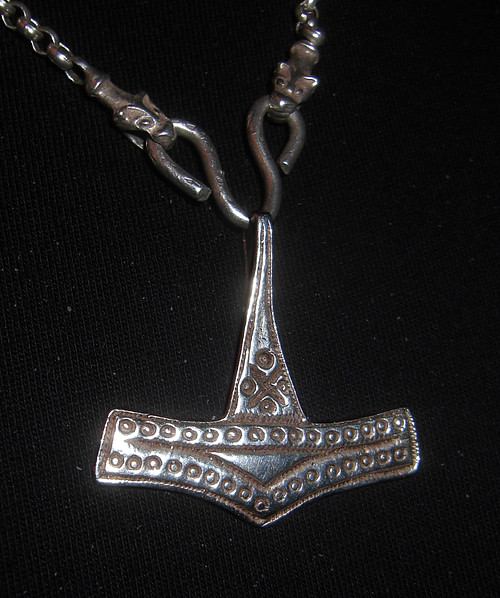
The image of Mjolnir appears most often as an amulet. When Scandinavians were resisting the pressures of the new religion of Christianity, smiths created Mjolnir amulets right alongside crosses and more amulets of Thor's hammer appear from this time (c. late 10th century - 11th century) than any other. Mjolnir was the great protector of order (Asgard, the home of the gods) against the forces of chaos (the giants of Jotunheim) and its loss was unthinkable. When it was stolen by one of the giants, Thor had to disguise himself as Freyja and pose as a bride to get it back.
Sventhorn
The Sventhorn ("sleep thorn") symbol is usually depicted as four harpoons in a row and was a magical image for defeating one's enemy by putting them to sleep. The symbol is mentioned in a number of Norse sagas but is probably best known from the Saga of the Volsungs, chapter 20, in which Odin uses the Sventhorn to put the Valkyrie Brynhild to sleep.
Exactly how a Sventhorn was used in daily life is unclear, but its purpose was to induce a deep sleep from which the victim would not awaken for a considerable length of time (or until the person who used it wanted them to). It appears in Norse literature sometimes as an actual physical item but also as a kind of spell in which the symbol is carved on a board of oak and placed beneath the head of a person (presumably already sleeping) who will then not wake up until the spell-caster wants them to.
Gungnir
Gungnir (Odin's Spear) was a symbol of power, protection, and authority. Its name means "the swaying one" in that it brings people to Odin (Simek, 124). Gungnir, like Mjolnir, was made by the dwarves and was used by Odin to sacrifice himself to himself. Odin pierces himself with Gungnir as he hangs on Yggdrasil in his quest for knowledge. The image of Odin's spear appears on ceramics and cremation urns from the 9th century onwards until the triumph of Christianity in Scandinavia. The spear has magical runes carved into the point which increases its accuracy and draws an opposing army toward Odin (in other words, guarantees they will die and be taken to Valhalla).

According to the Ynglinga Saga (to cite only one example), Odin would hurl Gungnir to strike terror into the hearts of his enemies: "Odin knew how to act so that his foes in battle became blind or deaf or panic-stricken and their weapons pierced no more than wands" (Davidson, Gods and Myths, 63). Accordingly, the first weapon thrown in a conflict would be a spear, representing Gungnir, encouraging a Norse or Viking army onwards to victory.
Ship
The Viking ship has become synonymous with Norse culture and for good reason: the ship was a potent symbol of life, livelihood, one's journey through life, and the afterlife, and was used by the Norse for transport, in trade, in warfare, and as a burial vessel for centuries. The oldest Nordic boat is the Als Boat (also known as Hjortspring Boat) from Denmark dated to c. 300 BCE and boats would continue to play an important role in Norse culture.
Ships and the sea played an overwhelming part in the life and imagination of the Norsemen. They were a constant factor in their everyday activities. After death, the ship was apparently supposed to carry the dead man to the afterworld. (Magnusson, 21)
The ship of the fertility god Freyr was said to be enormous but could be folded up easily and kept in his pocket. Freyr, one of the gods of the Vanir, was among the most popular (forming the trinity with Odin and Thor as the most powerful of the pantheon), and the ship came to be associated with the magical properties of the Vanir, such as transformation, which linked the ship with death and the afterlife. The most famous ship burial is the Oseberg Ship but ship burials, or graves made in the shape of ships or containing ship imagery, have been discovered in a number of different regions.
Huginn & Muninn
Huginn and Muninn were the ravens of Odin who represented thought and memory. The aftermath of a battle was considered a feast for ravens as much as for vultures, and the raven came to symbolize Odin and his hall of heroes in the afterlife as well as simply being an image of death and transformation. Birds, in general, were associated with the gods but the raven particularly with Odin. Davidson notes that "birds were sacrificed in the Viking Age both at funerals and as part of the great sacrifice for victory at Uppsala" and that the birds which most delighted in sacrificial victims were the ravens (Myths and Symbols, 98). The birds were also symbols of life, however, and assisted Odin in his role as veterinarian.

The image of Huginn and Muninn appear frequently on cremation urns and other objects associated with death. They obviously symbolize the intellectual aspects of Odin but, for the common mortal, would represent the potent memory of the deceased and thoughts about them.
Triskelion
The Triskelion (Odin's Horns) is an image of three interlocking horns symbolizing wisdom, poetic inspiration, Odin, and the connection between the three. Odin stole the Mead of Poetry from the giants, which had been brewed from the blood of Kvasir, the wisest man who had ever lived, and brought it to the gods, who then shared it with humanity. Whoever drank of the Mead of Poetry would be able to compose brilliant verse and, since poetry was associated with scholarship, would also have great wisdom.
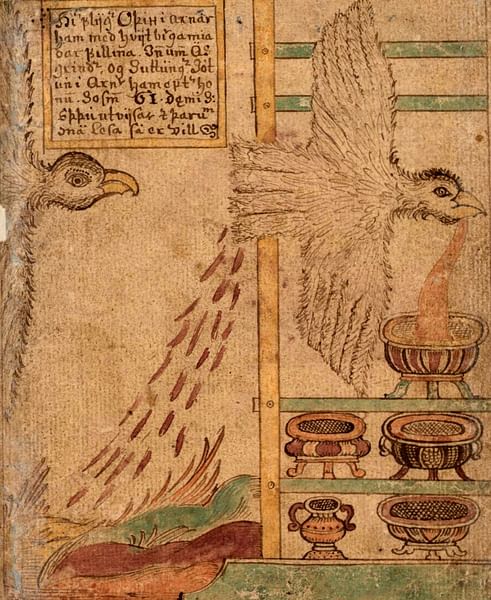
Odin was the god of alcohol, among his many other responsibilities, and so was associated with drinking and drinking parties. Davidson writes, "the drinking of wine, ale, or mead was of ceremonial importance at all feasts and it seems to have been this which 'hallowed' the hall when men met for sacrifice" (Myths and Symbols, 41). The interlocking horns emphasized the connection between those who met for communal gatherings with each other and with Odin.
Conclusion
These ten symbols and the many others used by the Norse and Vikings in their daily life held the same kind of importance as any religious iconography does for believers in the present day. Although one now refers to ancient Norse beliefs as 'mythology', those beliefs were just as real and valid to those who believed in them as the religion of any modern-day believer in whatever faith they may hold.
Pre-Christian Scandinavia was a world imbued with spirits and the living gods of the Norse pantheon. The hills and rivers, the sky and sea, were alive with these entities. When the thunder boomed it was Thor driving his chariot across the heavens, and when the fields sprouted it was Freyr or Freyja generating life from the earth. Odin, the chief of the gods, assured fallen warriors of continued existence in his great hall of Valhalla while unexpected turns of luck or chance could be attributed to the trickster god Loki who was always looking for new ways to cause some mischief.
The universe in which humans and gods lived was supported by the great world-tree Yggdrasil in which there were nine different realms, each one home to a different group of beings such as elves, dwarves, giants, and, of course, the gods, and humans. These realms were not distant heavens but close at hand, and one could be sure that, if one needed help, a god like Thor would hear one's plea and come quickly to aid. At the same time, however, a mischievous dwarf or spirit – or even a ghost – could just as easily show up outside one's door, and so various rituals and symbols were developed for protection.
In the same way that people today take comfort in the symbols of their religion, the people of Scandinavia relied on these symbols as representations that there was someone looking out for them. No matter how dangerous and uncertain the world might seem, by holding tight to an amulet of Thor's Hammer, one was assured that help was coming and that someone, somewhere, was watching over one's life and always offering peace and protection to the faithful.

